Nepalese Migrants in Australia: Opportunities and Challenges
VerifiedAdded on 2023/06/12
|12
|3648
|105
Report
AI Summary
This report examines the challenges and opportunities faced by Nepalese migrants in Australia, focusing on their experiences in employment, education, and social integration. It highlights the economic contributions of Nepalese migrants through remittances and their participation in various sectors of the Australian economy. The report also addresses the challenges they encounter, such as language barriers, healthcare access, and workplace safety, while also exploring opportunities for professional growth, skill development, and community engagement. Furthermore, it discusses the role of organizations in supporting Nepalese migrants and promoting cultural preservation. The study references various research and reports to provide a comprehensive overview of the situation, emphasizing the need for continued support and policies to enhance the well-being of Nepalese migrants in Australia.
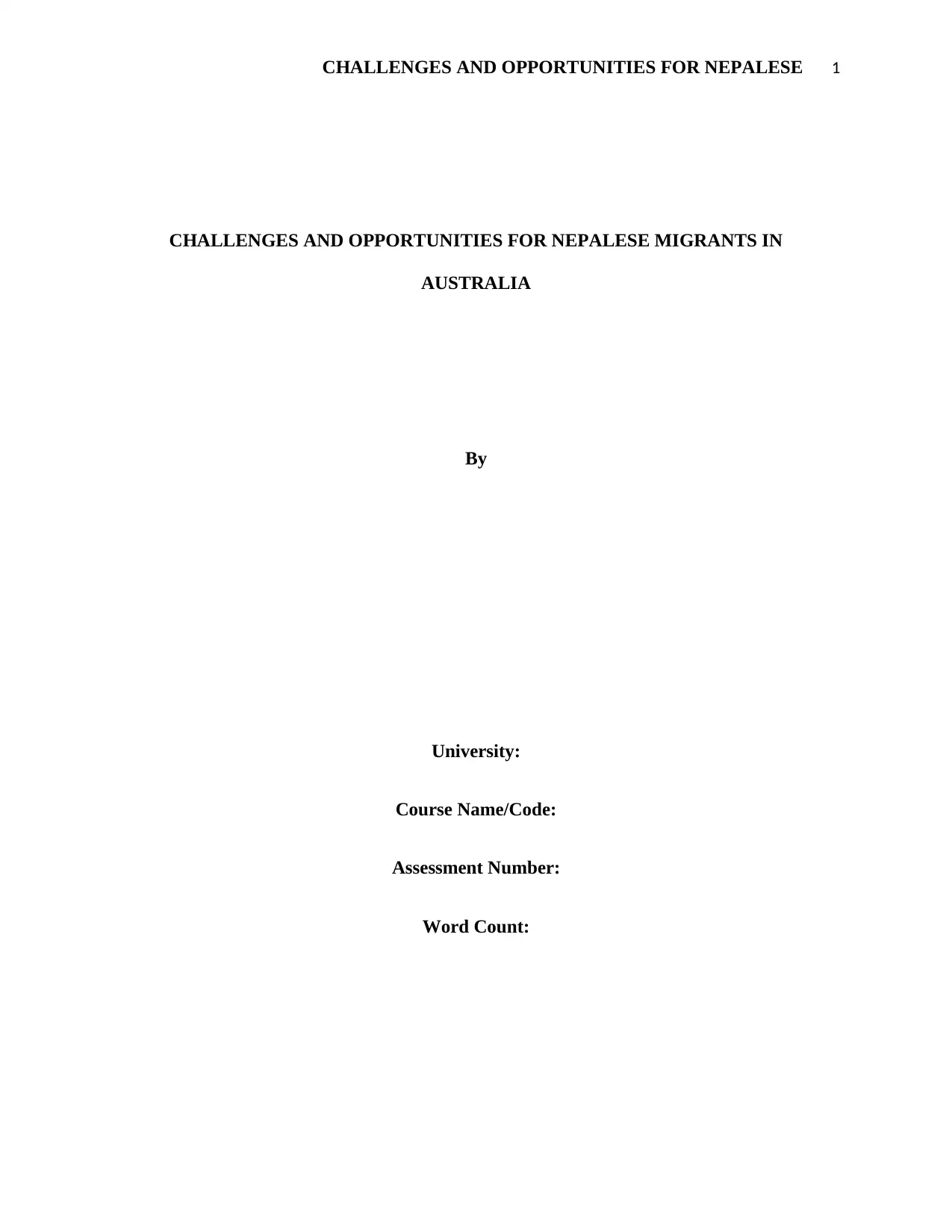
CHALLENGES AND OPPORTUNITIES FOR NEPALESE 1
CHALLENGES AND OPPORTUNITIES FOR NEPALESE MIGRANTS IN
AUSTRALIA
By
University:
Course Name/Code:
Assessment Number:
Word Count:
CHALLENGES AND OPPORTUNITIES FOR NEPALESE MIGRANTS IN
AUSTRALIA
By
University:
Course Name/Code:
Assessment Number:
Word Count:
Paraphrase This Document
Need a fresh take? Get an instant paraphrase of this document with our AI Paraphraser
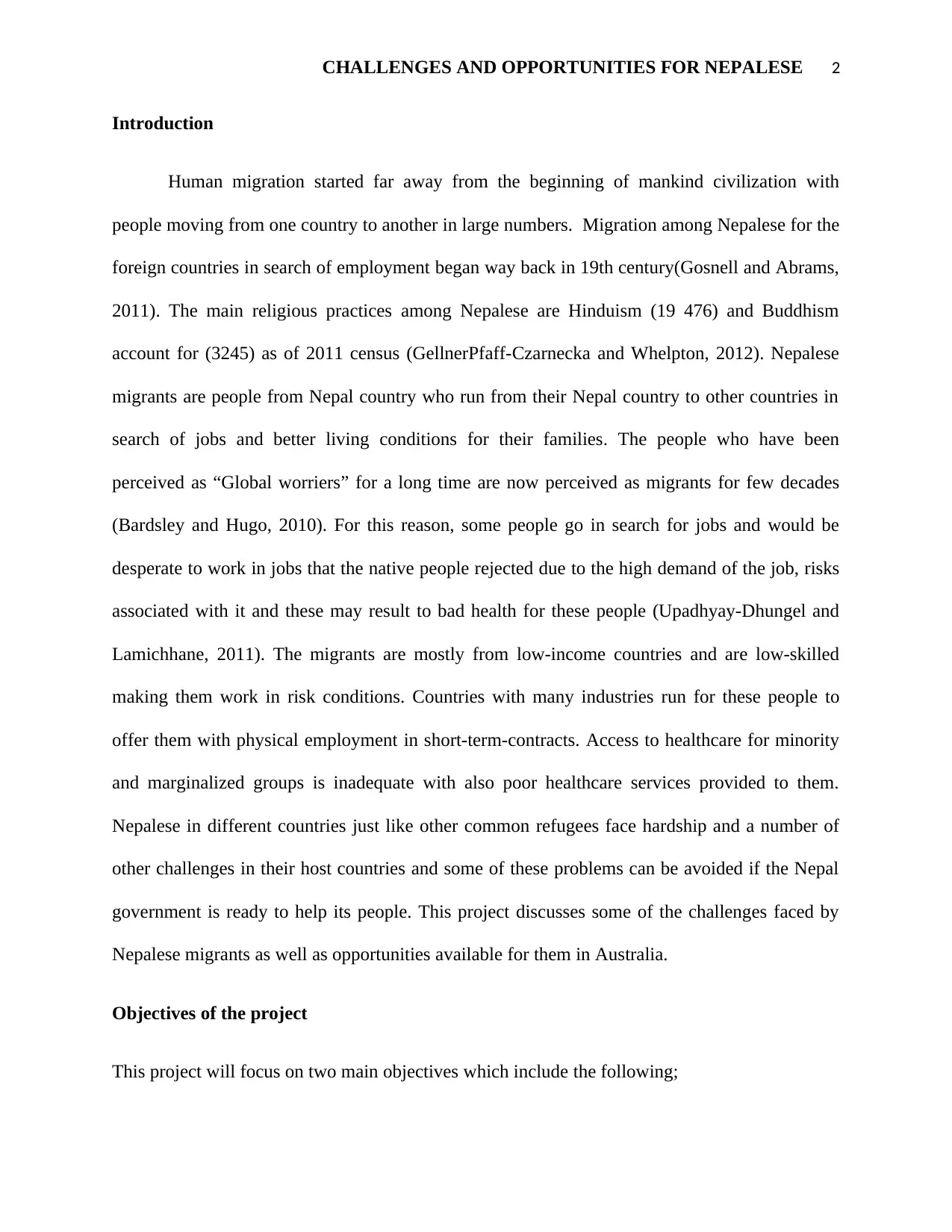
CHALLENGES AND OPPORTUNITIES FOR NEPALESE 2
Introduction
Human migration started far away from the beginning of mankind civilization with
people moving from one country to another in large numbers. Migration among Nepalese for the
foreign countries in search of employment began way back in 19th century(Gosnell and Abrams,
2011). The main religious practices among Nepalese are Hinduism (19 476) and Buddhism
account for (3245) as of 2011 census (GellnerPfaff-Czarnecka and Whelpton, 2012). Nepalese
migrants are people from Nepal country who run from their Nepal country to other countries in
search of jobs and better living conditions for their families. The people who have been
perceived as “Global worriers” for a long time are now perceived as migrants for few decades
(Bardsley and Hugo, 2010). For this reason, some people go in search for jobs and would be
desperate to work in jobs that the native people rejected due to the high demand of the job, risks
associated with it and these may result to bad health for these people (Upadhyay-Dhungel and
Lamichhane, 2011). The migrants are mostly from low-income countries and are low-skilled
making them work in risk conditions. Countries with many industries run for these people to
offer them with physical employment in short-term-contracts. Access to healthcare for minority
and marginalized groups is inadequate with also poor healthcare services provided to them.
Nepalese in different countries just like other common refugees face hardship and a number of
other challenges in their host countries and some of these problems can be avoided if the Nepal
government is ready to help its people. This project discusses some of the challenges faced by
Nepalese migrants as well as opportunities available for them in Australia.
Objectives of the project
This project will focus on two main objectives which include the following;
Introduction
Human migration started far away from the beginning of mankind civilization with
people moving from one country to another in large numbers. Migration among Nepalese for the
foreign countries in search of employment began way back in 19th century(Gosnell and Abrams,
2011). The main religious practices among Nepalese are Hinduism (19 476) and Buddhism
account for (3245) as of 2011 census (GellnerPfaff-Czarnecka and Whelpton, 2012). Nepalese
migrants are people from Nepal country who run from their Nepal country to other countries in
search of jobs and better living conditions for their families. The people who have been
perceived as “Global worriers” for a long time are now perceived as migrants for few decades
(Bardsley and Hugo, 2010). For this reason, some people go in search for jobs and would be
desperate to work in jobs that the native people rejected due to the high demand of the job, risks
associated with it and these may result to bad health for these people (Upadhyay-Dhungel and
Lamichhane, 2011). The migrants are mostly from low-income countries and are low-skilled
making them work in risk conditions. Countries with many industries run for these people to
offer them with physical employment in short-term-contracts. Access to healthcare for minority
and marginalized groups is inadequate with also poor healthcare services provided to them.
Nepalese in different countries just like other common refugees face hardship and a number of
other challenges in their host countries and some of these problems can be avoided if the Nepal
government is ready to help its people. This project discusses some of the challenges faced by
Nepalese migrants as well as opportunities available for them in Australia.
Objectives of the project
This project will focus on two main objectives which include the following;
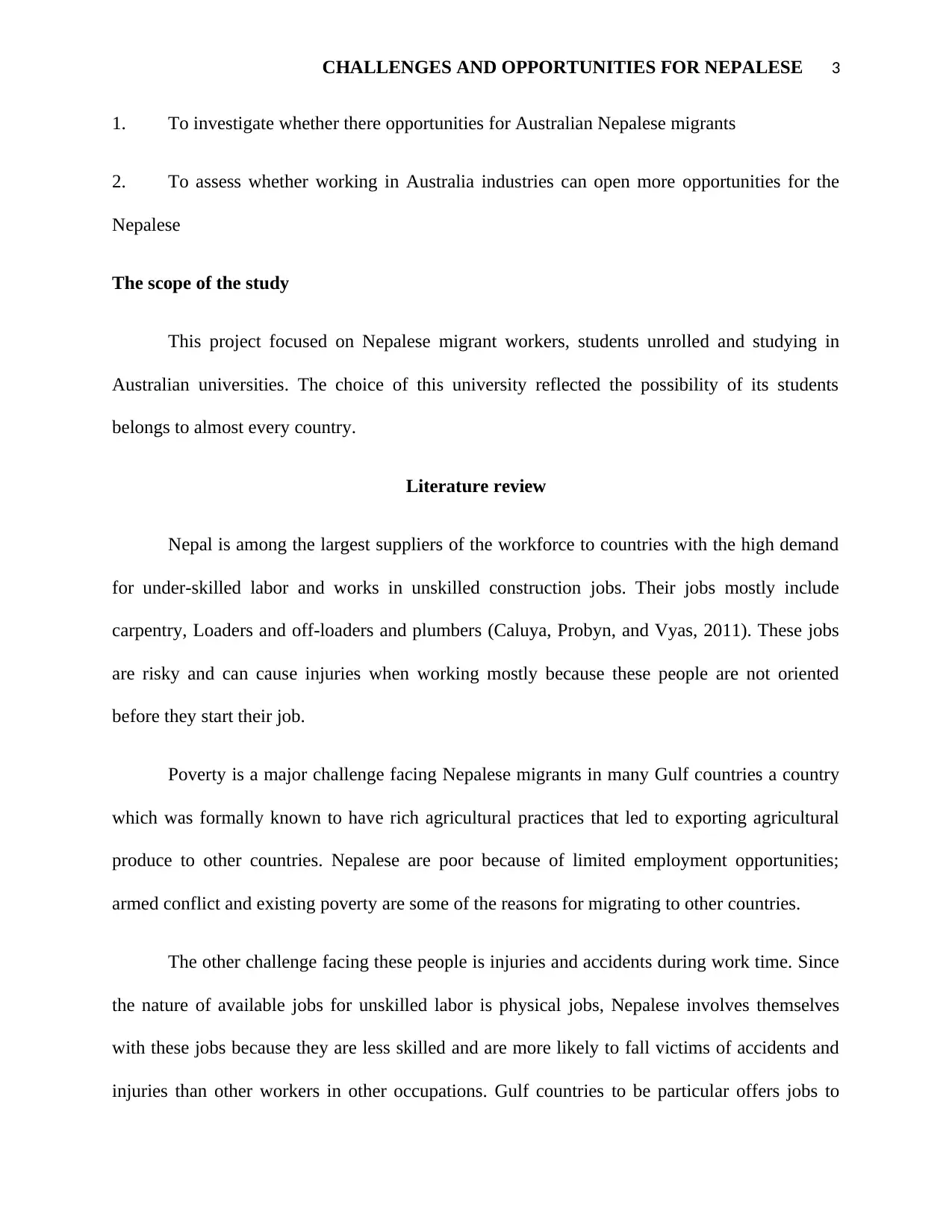
CHALLENGES AND OPPORTUNITIES FOR NEPALESE 3
1. To investigate whether there opportunities for Australian Nepalese migrants
2. To assess whether working in Australia industries can open more opportunities for the
Nepalese
The scope of the study
This project focused on Nepalese migrant workers, students unrolled and studying in
Australian universities. The choice of this university reflected the possibility of its students
belongs to almost every country.
Literature review
Nepal is among the largest suppliers of the workforce to countries with the high demand
for under-skilled labor and works in unskilled construction jobs. Their jobs mostly include
carpentry, Loaders and off-loaders and plumbers (Caluya, Probyn, and Vyas, 2011). These jobs
are risky and can cause injuries when working mostly because these people are not oriented
before they start their job.
Poverty is a major challenge facing Nepalese migrants in many Gulf countries a country
which was formally known to have rich agricultural practices that led to exporting agricultural
produce to other countries. Nepalese are poor because of limited employment opportunities;
armed conflict and existing poverty are some of the reasons for migrating to other countries.
The other challenge facing these people is injuries and accidents during work time. Since
the nature of available jobs for unskilled labor is physical jobs, Nepalese involves themselves
with these jobs because they are less skilled and are more likely to fall victims of accidents and
injuries than other workers in other occupations. Gulf countries to be particular offers jobs to
1. To investigate whether there opportunities for Australian Nepalese migrants
2. To assess whether working in Australia industries can open more opportunities for the
Nepalese
The scope of the study
This project focused on Nepalese migrant workers, students unrolled and studying in
Australian universities. The choice of this university reflected the possibility of its students
belongs to almost every country.
Literature review
Nepal is among the largest suppliers of the workforce to countries with the high demand
for under-skilled labor and works in unskilled construction jobs. Their jobs mostly include
carpentry, Loaders and off-loaders and plumbers (Caluya, Probyn, and Vyas, 2011). These jobs
are risky and can cause injuries when working mostly because these people are not oriented
before they start their job.
Poverty is a major challenge facing Nepalese migrants in many Gulf countries a country
which was formally known to have rich agricultural practices that led to exporting agricultural
produce to other countries. Nepalese are poor because of limited employment opportunities;
armed conflict and existing poverty are some of the reasons for migrating to other countries.
The other challenge facing these people is injuries and accidents during work time. Since
the nature of available jobs for unskilled labor is physical jobs, Nepalese involves themselves
with these jobs because they are less skilled and are more likely to fall victims of accidents and
injuries than other workers in other occupations. Gulf countries to be particular offers jobs to
⊘ This is a preview!⊘
Do you want full access?
Subscribe today to unlock all pages.

Trusted by 1+ million students worldwide
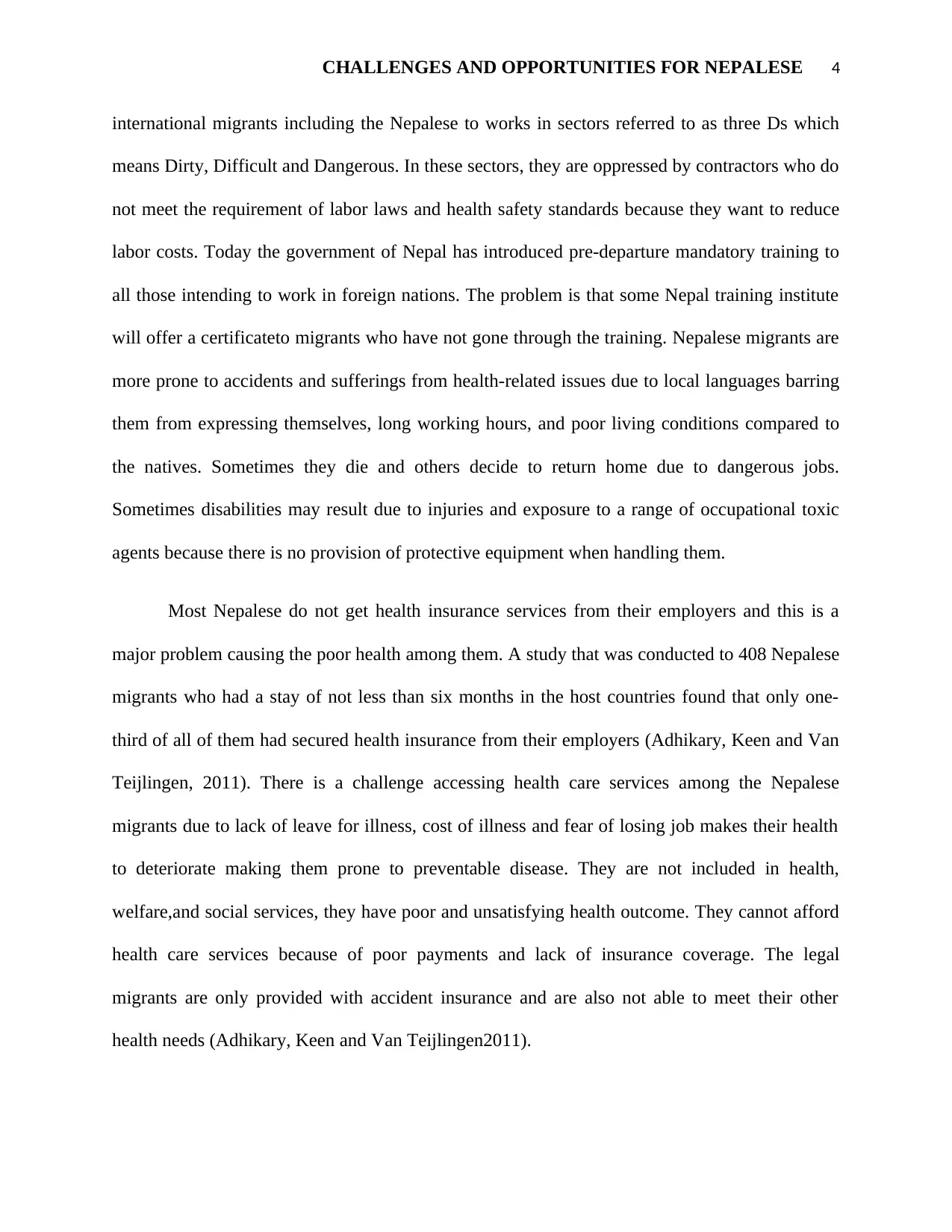
CHALLENGES AND OPPORTUNITIES FOR NEPALESE 4
international migrants including the Nepalese to works in sectors referred to as three Ds which
means Dirty, Difficult and Dangerous. In these sectors, they are oppressed by contractors who do
not meet the requirement of labor laws and health safety standards because they want to reduce
labor costs. Today the government of Nepal has introduced pre-departure mandatory training to
all those intending to work in foreign nations. The problem is that some Nepal training institute
will offer a certificateto migrants who have not gone through the training. Nepalese migrants are
more prone to accidents and sufferings from health-related issues due to local languages barring
them from expressing themselves, long working hours, and poor living conditions compared to
the natives. Sometimes they die and others decide to return home due to dangerous jobs.
Sometimes disabilities may result due to injuries and exposure to a range of occupational toxic
agents because there is no provision of protective equipment when handling them.
Most Nepalese do not get health insurance services from their employers and this is a
major problem causing the poor health among them. A study that was conducted to 408 Nepalese
migrants who had a stay of not less than six months in the host countries found that only one-
third of all of them had secured health insurance from their employers (Adhikary, Keen and Van
Teijlingen, 2011). There is a challenge accessing health care services among the Nepalese
migrants due to lack of leave for illness, cost of illness and fear of losing job makes their health
to deteriorate making them prone to preventable disease. They are not included in health,
welfare,and social services, they have poor and unsatisfying health outcome. They cannot afford
health care services because of poor payments and lack of insurance coverage. The legal
migrants are only provided with accident insurance and are also not able to meet their other
health needs (Adhikary, Keen and Van Teijlingen2011).
international migrants including the Nepalese to works in sectors referred to as three Ds which
means Dirty, Difficult and Dangerous. In these sectors, they are oppressed by contractors who do
not meet the requirement of labor laws and health safety standards because they want to reduce
labor costs. Today the government of Nepal has introduced pre-departure mandatory training to
all those intending to work in foreign nations. The problem is that some Nepal training institute
will offer a certificateto migrants who have not gone through the training. Nepalese migrants are
more prone to accidents and sufferings from health-related issues due to local languages barring
them from expressing themselves, long working hours, and poor living conditions compared to
the natives. Sometimes they die and others decide to return home due to dangerous jobs.
Sometimes disabilities may result due to injuries and exposure to a range of occupational toxic
agents because there is no provision of protective equipment when handling them.
Most Nepalese do not get health insurance services from their employers and this is a
major problem causing the poor health among them. A study that was conducted to 408 Nepalese
migrants who had a stay of not less than six months in the host countries found that only one-
third of all of them had secured health insurance from their employers (Adhikary, Keen and Van
Teijlingen, 2011). There is a challenge accessing health care services among the Nepalese
migrants due to lack of leave for illness, cost of illness and fear of losing job makes their health
to deteriorate making them prone to preventable disease. They are not included in health,
welfare,and social services, they have poor and unsatisfying health outcome. They cannot afford
health care services because of poor payments and lack of insurance coverage. The legal
migrants are only provided with accident insurance and are also not able to meet their other
health needs (Adhikary, Keen and Van Teijlingen2011).
Paraphrase This Document
Need a fresh take? Get an instant paraphrase of this document with our AI Paraphraser
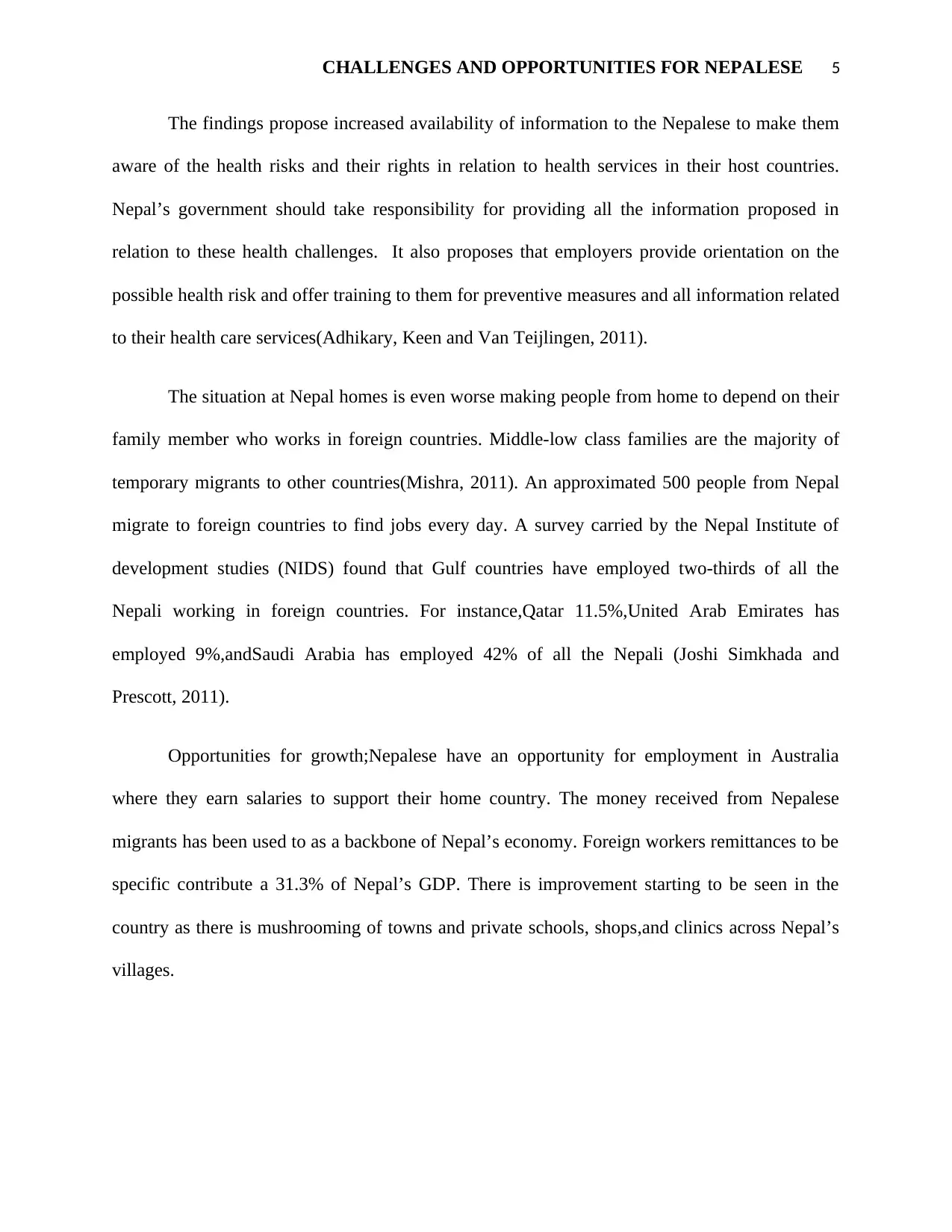
CHALLENGES AND OPPORTUNITIES FOR NEPALESE 5
The findings propose increased availability of information to the Nepalese to make them
aware of the health risks and their rights in relation to health services in their host countries.
Nepal’s government should take responsibility for providing all the information proposed in
relation to these health challenges. It also proposes that employers provide orientation on the
possible health risk and offer training to them for preventive measures and all information related
to their health care services(Adhikary, Keen and Van Teijlingen, 2011).
The situation at Nepal homes is even worse making people from home to depend on their
family member who works in foreign countries. Middle-low class families are the majority of
temporary migrants to other countries(Mishra, 2011). An approximated 500 people from Nepal
migrate to foreign countries to find jobs every day. A survey carried by the Nepal Institute of
development studies (NIDS) found that Gulf countries have employed two-thirds of all the
Nepali working in foreign countries. For instance,Qatar 11.5%,United Arab Emirates has
employed 9%,andSaudi Arabia has employed 42% of all the Nepali (Joshi Simkhada and
Prescott, 2011).
Opportunities for growth;Nepalese have an opportunity for employment in Australia
where they earn salaries to support their home country. The money received from Nepalese
migrants has been used to as a backbone of Nepal’s economy. Foreign workers remittances to be
specific contribute a 31.3% of Nepal’s GDP. There is improvement starting to be seen in the
country as there is mushrooming of towns and private schools, shops,and clinics across Nepal’s
villages.
The findings propose increased availability of information to the Nepalese to make them
aware of the health risks and their rights in relation to health services in their host countries.
Nepal’s government should take responsibility for providing all the information proposed in
relation to these health challenges. It also proposes that employers provide orientation on the
possible health risk and offer training to them for preventive measures and all information related
to their health care services(Adhikary, Keen and Van Teijlingen, 2011).
The situation at Nepal homes is even worse making people from home to depend on their
family member who works in foreign countries. Middle-low class families are the majority of
temporary migrants to other countries(Mishra, 2011). An approximated 500 people from Nepal
migrate to foreign countries to find jobs every day. A survey carried by the Nepal Institute of
development studies (NIDS) found that Gulf countries have employed two-thirds of all the
Nepali working in foreign countries. For instance,Qatar 11.5%,United Arab Emirates has
employed 9%,andSaudi Arabia has employed 42% of all the Nepali (Joshi Simkhada and
Prescott, 2011).
Opportunities for growth;Nepalese have an opportunity for employment in Australia
where they earn salaries to support their home country. The money received from Nepalese
migrants has been used to as a backbone of Nepal’s economy. Foreign workers remittances to be
specific contribute a 31.3% of Nepal’s GDP. There is improvement starting to be seen in the
country as there is mushrooming of towns and private schools, shops,and clinics across Nepal’s
villages.
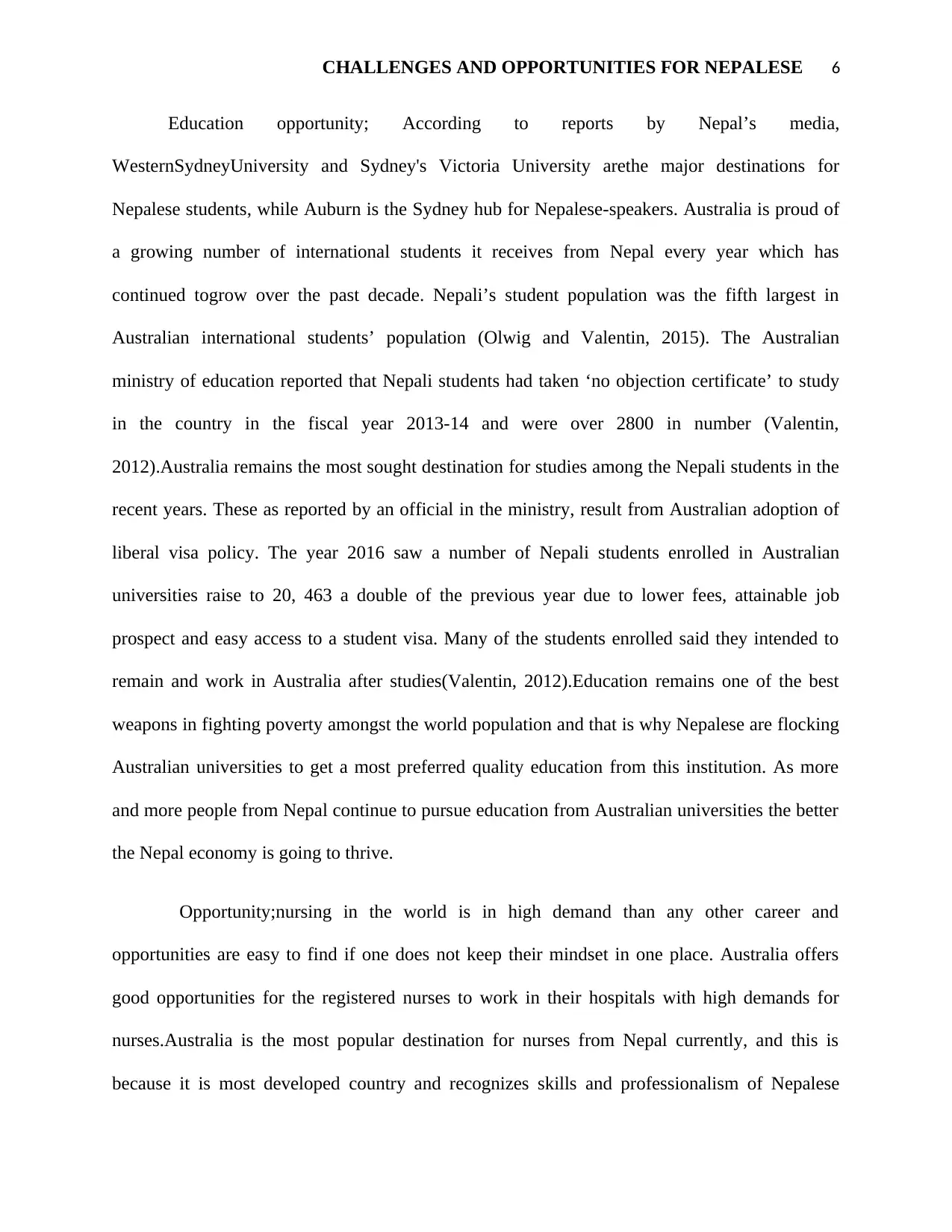
CHALLENGES AND OPPORTUNITIES FOR NEPALESE 6
Education opportunity; According to reports by Nepal’s media,
WesternSydneyUniversity and Sydney's Victoria University arethe major destinations for
Nepalese students, while Auburn is the Sydney hub for Nepalese-speakers. Australia is proud of
a growing number of international students it receives from Nepal every year which has
continued togrow over the past decade. Nepali’s student population was the fifth largest in
Australian international students’ population (Olwig and Valentin, 2015). The Australian
ministry of education reported that Nepali students had taken ‘no objection certificate’ to study
in the country in the fiscal year 2013-14 and were over 2800 in number (Valentin,
2012).Australia remains the most sought destination for studies among the Nepali students in the
recent years. These as reported by an official in the ministry, result from Australian adoption of
liberal visa policy. The year 2016 saw a number of Nepali students enrolled in Australian
universities raise to 20, 463 a double of the previous year due to lower fees, attainable job
prospect and easy access to a student visa. Many of the students enrolled said they intended to
remain and work in Australia after studies(Valentin, 2012).Education remains one of the best
weapons in fighting poverty amongst the world population and that is why Nepalese are flocking
Australian universities to get a most preferred quality education from this institution. As more
and more people from Nepal continue to pursue education from Australian universities the better
the Nepal economy is going to thrive.
Opportunity;nursing in the world is in high demand than any other career and
opportunities are easy to find if one does not keep their mindset in one place. Australia offers
good opportunities for the registered nurses to work in their hospitals with high demands for
nurses.Australia is the most popular destination for nurses from Nepal currently, and this is
because it is most developed country and recognizes skills and professionalism of Nepalese
Education opportunity; According to reports by Nepal’s media,
WesternSydneyUniversity and Sydney's Victoria University arethe major destinations for
Nepalese students, while Auburn is the Sydney hub for Nepalese-speakers. Australia is proud of
a growing number of international students it receives from Nepal every year which has
continued togrow over the past decade. Nepali’s student population was the fifth largest in
Australian international students’ population (Olwig and Valentin, 2015). The Australian
ministry of education reported that Nepali students had taken ‘no objection certificate’ to study
in the country in the fiscal year 2013-14 and were over 2800 in number (Valentin,
2012).Australia remains the most sought destination for studies among the Nepali students in the
recent years. These as reported by an official in the ministry, result from Australian adoption of
liberal visa policy. The year 2016 saw a number of Nepali students enrolled in Australian
universities raise to 20, 463 a double of the previous year due to lower fees, attainable job
prospect and easy access to a student visa. Many of the students enrolled said they intended to
remain and work in Australia after studies(Valentin, 2012).Education remains one of the best
weapons in fighting poverty amongst the world population and that is why Nepalese are flocking
Australian universities to get a most preferred quality education from this institution. As more
and more people from Nepal continue to pursue education from Australian universities the better
the Nepal economy is going to thrive.
Opportunity;nursing in the world is in high demand than any other career and
opportunities are easy to find if one does not keep their mindset in one place. Australia offers
good opportunities for the registered nurses to work in their hospitals with high demands for
nurses.Australia is the most popular destination for nurses from Nepal currently, and this is
because it is most developed country and recognizes skills and professionalism of Nepalese
⊘ This is a preview!⊘
Do you want full access?
Subscribe today to unlock all pages.

Trusted by 1+ million students worldwide
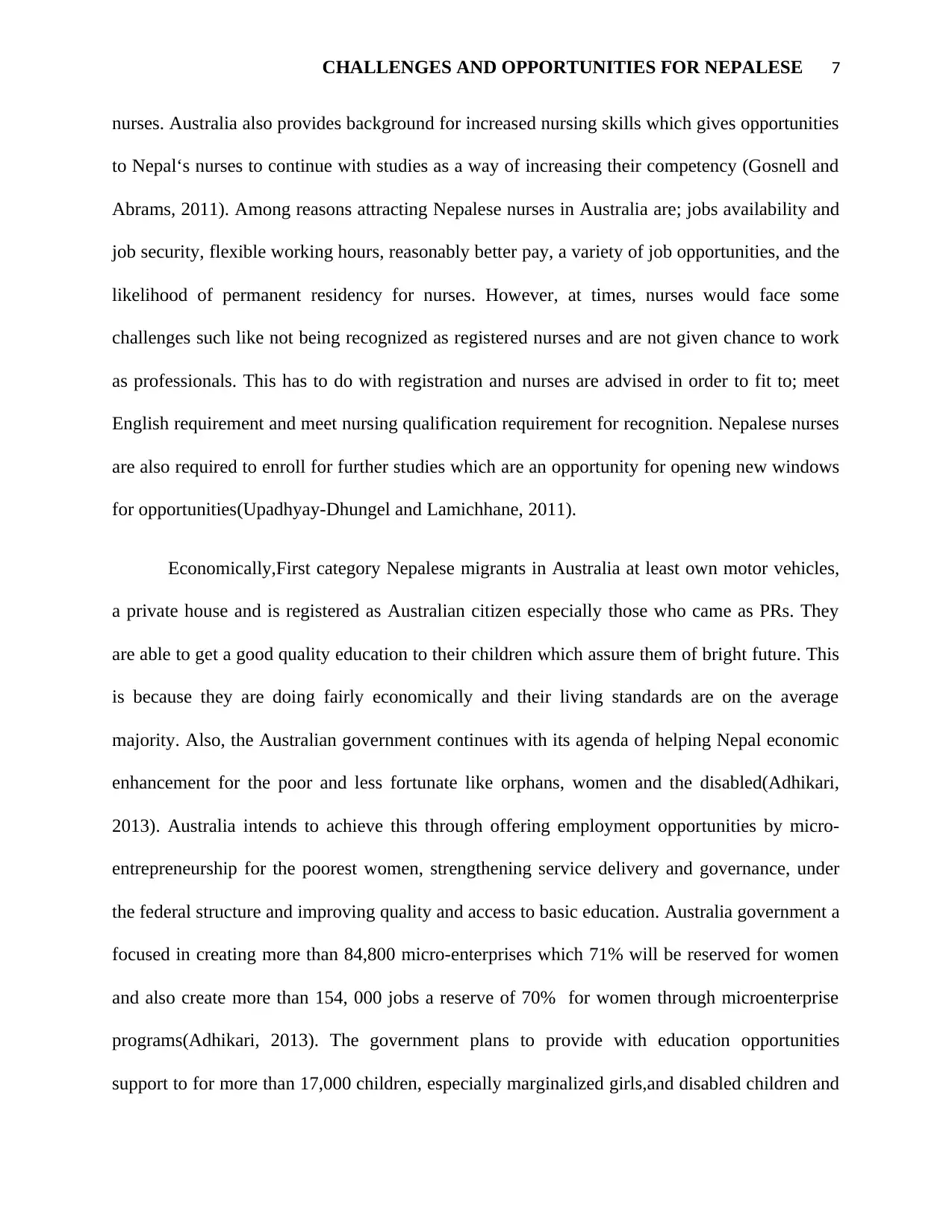
CHALLENGES AND OPPORTUNITIES FOR NEPALESE 7
nurses. Australia also provides background for increased nursing skills which gives opportunities
to Nepal‘s nurses to continue with studies as a way of increasing their competency (Gosnell and
Abrams, 2011). Among reasons attracting Nepalese nurses in Australia are; jobs availability and
job security, flexible working hours, reasonably better pay, a variety of job opportunities, and the
likelihood of permanent residency for nurses. However, at times, nurses would face some
challenges such like not being recognized as registered nurses and are not given chance to work
as professionals. This has to do with registration and nurses are advised in order to fit to; meet
English requirement and meet nursing qualification requirement for recognition. Nepalese nurses
are also required to enroll for further studies which are an opportunity for opening new windows
for opportunities(Upadhyay-Dhungel and Lamichhane, 2011).
Economically,First category Nepalese migrants in Australia at least own motor vehicles,
a private house and is registered as Australian citizen especially those who came as PRs. They
are able to get a good quality education to their children which assure them of bright future. This
is because they are doing fairly economically and their living standards are on the average
majority. Also, the Australian government continues with its agenda of helping Nepal economic
enhancement for the poor and less fortunate like orphans, women and the disabled(Adhikari,
2013). Australia intends to achieve this through offering employment opportunities by micro-
entrepreneurship for the poorest women, strengthening service delivery and governance, under
the federal structure and improving quality and access to basic education. Australia government a
focused in creating more than 84,800 micro-enterprises which 71% will be reserved for women
and also create more than 154, 000 jobs a reserve of 70% for women through microenterprise
programs(Adhikari, 2013). The government plans to provide with education opportunities
support to for more than 17,000 children, especially marginalized girls,and disabled children and
nurses. Australia also provides background for increased nursing skills which gives opportunities
to Nepal‘s nurses to continue with studies as a way of increasing their competency (Gosnell and
Abrams, 2011). Among reasons attracting Nepalese nurses in Australia are; jobs availability and
job security, flexible working hours, reasonably better pay, a variety of job opportunities, and the
likelihood of permanent residency for nurses. However, at times, nurses would face some
challenges such like not being recognized as registered nurses and are not given chance to work
as professionals. This has to do with registration and nurses are advised in order to fit to; meet
English requirement and meet nursing qualification requirement for recognition. Nepalese nurses
are also required to enroll for further studies which are an opportunity for opening new windows
for opportunities(Upadhyay-Dhungel and Lamichhane, 2011).
Economically,First category Nepalese migrants in Australia at least own motor vehicles,
a private house and is registered as Australian citizen especially those who came as PRs. They
are able to get a good quality education to their children which assure them of bright future. This
is because they are doing fairly economically and their living standards are on the average
majority. Also, the Australian government continues with its agenda of helping Nepal economic
enhancement for the poor and less fortunate like orphans, women and the disabled(Adhikari,
2013). Australia intends to achieve this through offering employment opportunities by micro-
entrepreneurship for the poorest women, strengthening service delivery and governance, under
the federal structure and improving quality and access to basic education. Australia government a
focused in creating more than 84,800 micro-enterprises which 71% will be reserved for women
and also create more than 154, 000 jobs a reserve of 70% for women through microenterprise
programs(Adhikari, 2013). The government plans to provide with education opportunities
support to for more than 17,000 children, especially marginalized girls,and disabled children and
Paraphrase This Document
Need a fresh take? Get an instant paraphrase of this document with our AI Paraphraser
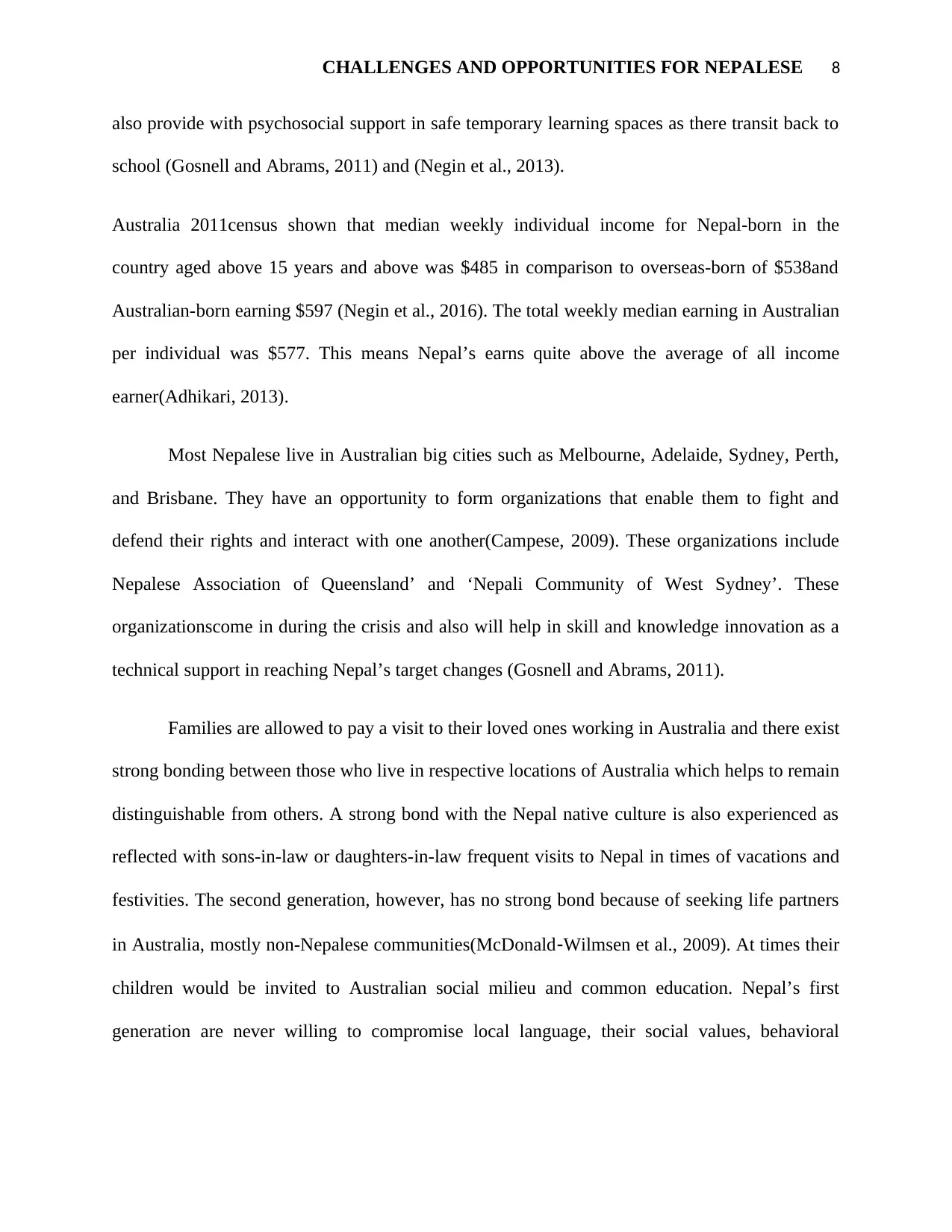
CHALLENGES AND OPPORTUNITIES FOR NEPALESE 8
also provide with psychosocial support in safe temporary learning spaces as there transit back to
school (Gosnell and Abrams, 2011) and (Negin et al., 2013).
Australia 2011census shown that median weekly individual income for Nepal-born in the
country aged above 15 years and above was $485 in comparison to overseas-born of $538and
Australian-born earning $597 (Negin et al., 2016). The total weekly median earning in Australian
per individual was $577. This means Nepal’s earns quite above the average of all income
earner(Adhikari, 2013).
Most Nepalese live in Australian big cities such as Melbourne, Adelaide, Sydney, Perth,
and Brisbane. They have an opportunity to form organizations that enable them to fight and
defend their rights and interact with one another(Campese, 2009). These organizations include
Nepalese Association of Queensland’ and ‘Nepali Community of West Sydney’. These
organizationscome in during the crisis and also will help in skill and knowledge innovation as a
technical support in reaching Nepal’s target changes (Gosnell and Abrams, 2011).
Families are allowed to pay a visit to their loved ones working in Australia and there exist
strong bonding between those who live in respective locations of Australia which helps to remain
distinguishable from others. A strong bond with the Nepal native culture is also experienced as
reflected with sons-in-law or daughters-in-law frequent visits to Nepal in times of vacations and
festivities. The second generation, however, has no strong bond because of seeking life partners
in Australia, mostly non-Nepalese communities(McDonald‐Wilmsen et al., 2009). At times their
children would be invited to Australian social milieu and common education. Nepal’s first
generation are never willing to compromise local language, their social values, behavioral
also provide with psychosocial support in safe temporary learning spaces as there transit back to
school (Gosnell and Abrams, 2011) and (Negin et al., 2013).
Australia 2011census shown that median weekly individual income for Nepal-born in the
country aged above 15 years and above was $485 in comparison to overseas-born of $538and
Australian-born earning $597 (Negin et al., 2016). The total weekly median earning in Australian
per individual was $577. This means Nepal’s earns quite above the average of all income
earner(Adhikari, 2013).
Most Nepalese live in Australian big cities such as Melbourne, Adelaide, Sydney, Perth,
and Brisbane. They have an opportunity to form organizations that enable them to fight and
defend their rights and interact with one another(Campese, 2009). These organizations include
Nepalese Association of Queensland’ and ‘Nepali Community of West Sydney’. These
organizationscome in during the crisis and also will help in skill and knowledge innovation as a
technical support in reaching Nepal’s target changes (Gosnell and Abrams, 2011).
Families are allowed to pay a visit to their loved ones working in Australia and there exist
strong bonding between those who live in respective locations of Australia which helps to remain
distinguishable from others. A strong bond with the Nepal native culture is also experienced as
reflected with sons-in-law or daughters-in-law frequent visits to Nepal in times of vacations and
festivities. The second generation, however, has no strong bond because of seeking life partners
in Australia, mostly non-Nepalese communities(McDonald‐Wilmsen et al., 2009). At times their
children would be invited to Australian social milieu and common education. Nepal’s first
generation are never willing to compromise local language, their social values, behavioral
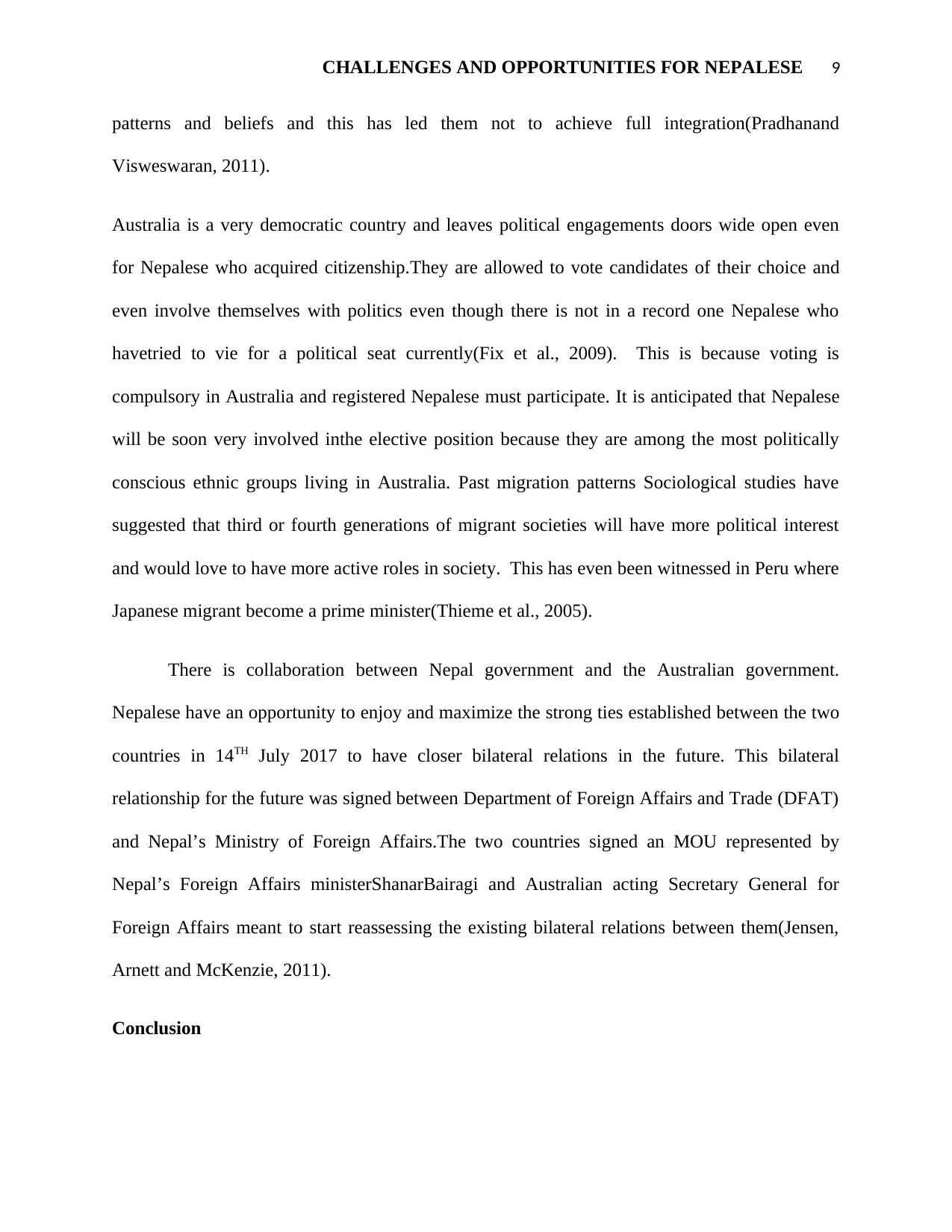
CHALLENGES AND OPPORTUNITIES FOR NEPALESE 9
patterns and beliefs and this has led them not to achieve full integration(Pradhanand
Visweswaran, 2011).
Australia is a very democratic country and leaves political engagements doors wide open even
for Nepalese who acquired citizenship.They are allowed to vote candidates of their choice and
even involve themselves with politics even though there is not in a record one Nepalese who
havetried to vie for a political seat currently(Fix et al., 2009). This is because voting is
compulsory in Australia and registered Nepalese must participate. It is anticipated that Nepalese
will be soon very involved inthe elective position because they are among the most politically
conscious ethnic groups living in Australia. Past migration patterns Sociological studies have
suggested that third or fourth generations of migrant societies will have more political interest
and would love to have more active roles in society. This has even been witnessed in Peru where
Japanese migrant become a prime minister(Thieme et al., 2005).
There is collaboration between Nepal government and the Australian government.
Nepalese have an opportunity to enjoy and maximize the strong ties established between the two
countries in 14TH July 2017 to have closer bilateral relations in the future. This bilateral
relationship for the future was signed between Department of Foreign Affairs and Trade (DFAT)
and Nepal’s Ministry of Foreign Affairs.The two countries signed an MOU represented by
Nepal’s Foreign Affairs ministerShanarBairagi and Australian acting Secretary General for
Foreign Affairs meant to start reassessing the existing bilateral relations between them(Jensen,
Arnett and McKenzie, 2011).
Conclusion
patterns and beliefs and this has led them not to achieve full integration(Pradhanand
Visweswaran, 2011).
Australia is a very democratic country and leaves political engagements doors wide open even
for Nepalese who acquired citizenship.They are allowed to vote candidates of their choice and
even involve themselves with politics even though there is not in a record one Nepalese who
havetried to vie for a political seat currently(Fix et al., 2009). This is because voting is
compulsory in Australia and registered Nepalese must participate. It is anticipated that Nepalese
will be soon very involved inthe elective position because they are among the most politically
conscious ethnic groups living in Australia. Past migration patterns Sociological studies have
suggested that third or fourth generations of migrant societies will have more political interest
and would love to have more active roles in society. This has even been witnessed in Peru where
Japanese migrant become a prime minister(Thieme et al., 2005).
There is collaboration between Nepal government and the Australian government.
Nepalese have an opportunity to enjoy and maximize the strong ties established between the two
countries in 14TH July 2017 to have closer bilateral relations in the future. This bilateral
relationship for the future was signed between Department of Foreign Affairs and Trade (DFAT)
and Nepal’s Ministry of Foreign Affairs.The two countries signed an MOU represented by
Nepal’s Foreign Affairs ministerShanarBairagi and Australian acting Secretary General for
Foreign Affairs meant to start reassessing the existing bilateral relations between them(Jensen,
Arnett and McKenzie, 2011).
Conclusion
⊘ This is a preview!⊘
Do you want full access?
Subscribe today to unlock all pages.

Trusted by 1+ million students worldwide
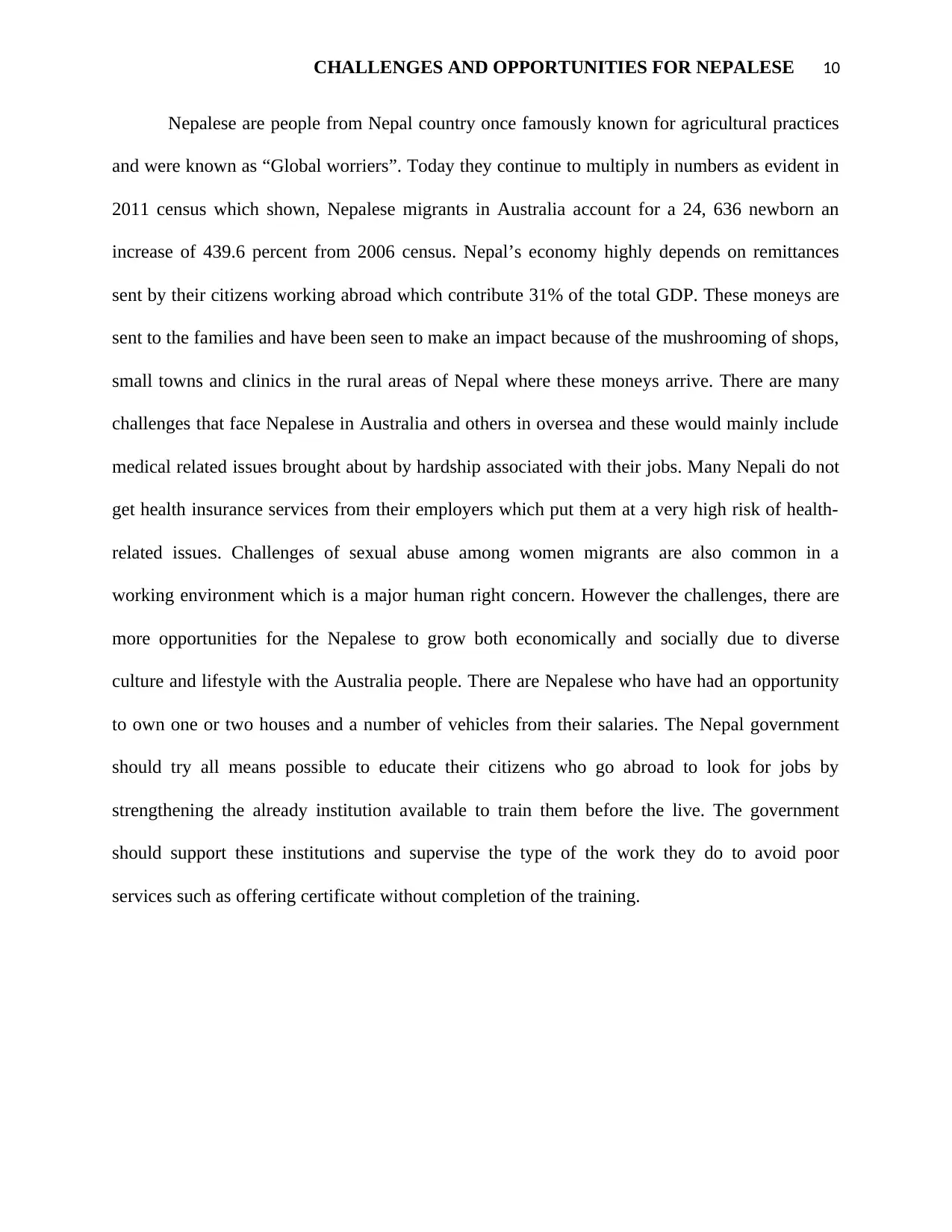
CHALLENGES AND OPPORTUNITIES FOR NEPALESE 10
Nepalese are people from Nepal country once famously known for agricultural practices
and were known as “Global worriers”. Today they continue to multiply in numbers as evident in
2011 census which shown, Nepalese migrants in Australia account for a 24, 636 newborn an
increase of 439.6 percent from 2006 census. Nepal’s economy highly depends on remittances
sent by their citizens working abroad which contribute 31% of the total GDP. These moneys are
sent to the families and have been seen to make an impact because of the mushrooming of shops,
small towns and clinics in the rural areas of Nepal where these moneys arrive. There are many
challenges that face Nepalese in Australia and others in oversea and these would mainly include
medical related issues brought about by hardship associated with their jobs. Many Nepali do not
get health insurance services from their employers which put them at a very high risk of health-
related issues. Challenges of sexual abuse among women migrants are also common in a
working environment which is a major human right concern. However the challenges, there are
more opportunities for the Nepalese to grow both economically and socially due to diverse
culture and lifestyle with the Australia people. There are Nepalese who have had an opportunity
to own one or two houses and a number of vehicles from their salaries. The Nepal government
should try all means possible to educate their citizens who go abroad to look for jobs by
strengthening the already institution available to train them before the live. The government
should support these institutions and supervise the type of the work they do to avoid poor
services such as offering certificate without completion of the training.
Nepalese are people from Nepal country once famously known for agricultural practices
and were known as “Global worriers”. Today they continue to multiply in numbers as evident in
2011 census which shown, Nepalese migrants in Australia account for a 24, 636 newborn an
increase of 439.6 percent from 2006 census. Nepal’s economy highly depends on remittances
sent by their citizens working abroad which contribute 31% of the total GDP. These moneys are
sent to the families and have been seen to make an impact because of the mushrooming of shops,
small towns and clinics in the rural areas of Nepal where these moneys arrive. There are many
challenges that face Nepalese in Australia and others in oversea and these would mainly include
medical related issues brought about by hardship associated with their jobs. Many Nepali do not
get health insurance services from their employers which put them at a very high risk of health-
related issues. Challenges of sexual abuse among women migrants are also common in a
working environment which is a major human right concern. However the challenges, there are
more opportunities for the Nepalese to grow both economically and socially due to diverse
culture and lifestyle with the Australia people. There are Nepalese who have had an opportunity
to own one or two houses and a number of vehicles from their salaries. The Nepal government
should try all means possible to educate their citizens who go abroad to look for jobs by
strengthening the already institution available to train them before the live. The government
should support these institutions and supervise the type of the work they do to avoid poor
services such as offering certificate without completion of the training.
Paraphrase This Document
Need a fresh take? Get an instant paraphrase of this document with our AI Paraphraser
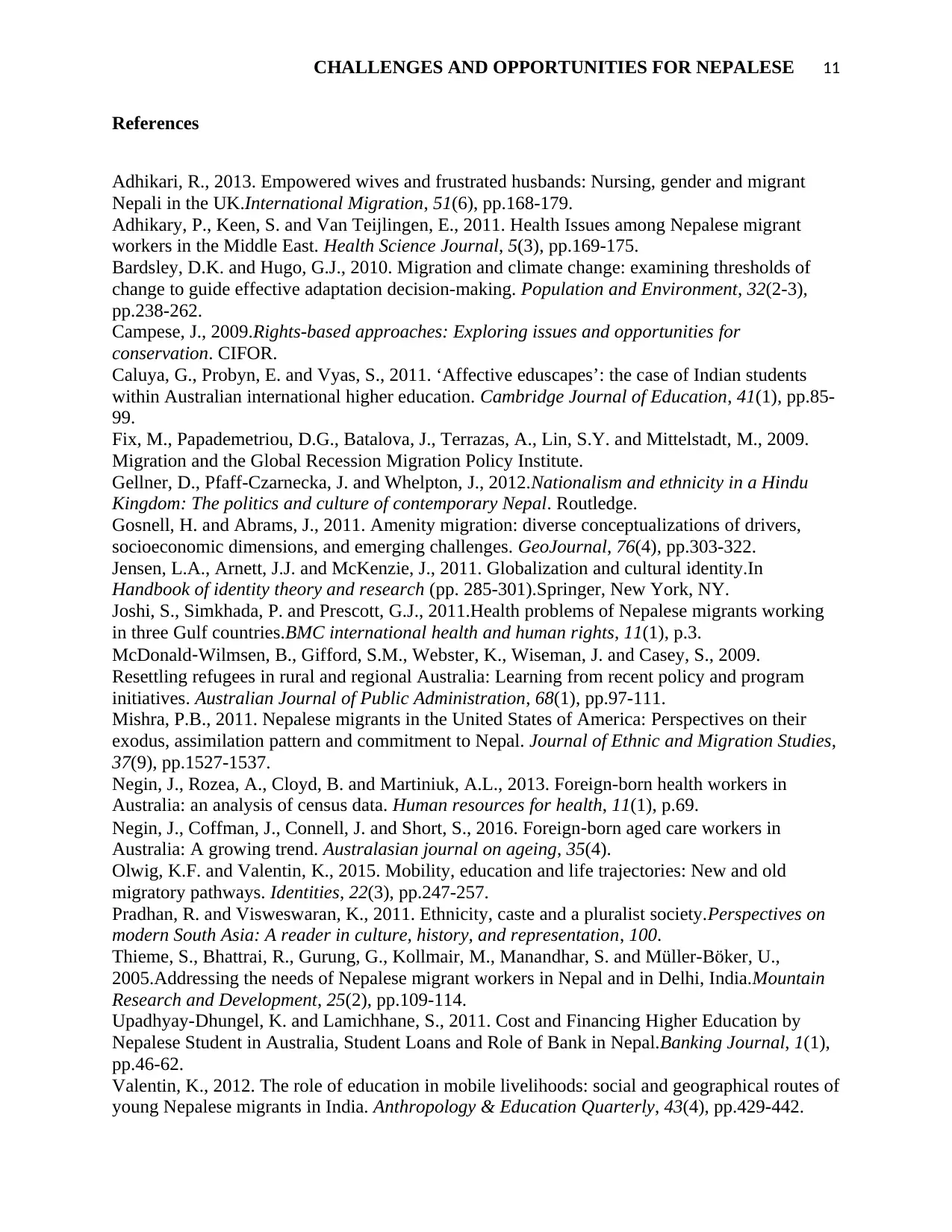
CHALLENGES AND OPPORTUNITIES FOR NEPALESE 11
References
Adhikari, R., 2013. Empowered wives and frustrated husbands: Nursing, gender and migrant
Nepali in the UK.International Migration, 51(6), pp.168-179.
Adhikary, P., Keen, S. and Van Teijlingen, E., 2011. Health Issues among Nepalese migrant
workers in the Middle East. Health Science Journal, 5(3), pp.169-175.
Bardsley, D.K. and Hugo, G.J., 2010. Migration and climate change: examining thresholds of
change to guide effective adaptation decision-making. Population and Environment, 32(2-3),
pp.238-262.
Campese, J., 2009.Rights-based approaches: Exploring issues and opportunities for
conservation. CIFOR.
Caluya, G., Probyn, E. and Vyas, S., 2011. ‘Affective eduscapes’: the case of Indian students
within Australian international higher education. Cambridge Journal of Education, 41(1), pp.85-
99.
Fix, M., Papademetriou, D.G., Batalova, J., Terrazas, A., Lin, S.Y. and Mittelstadt, M., 2009.
Migration and the Global Recession Migration Policy Institute.
Gellner, D., Pfaff-Czarnecka, J. and Whelpton, J., 2012.Nationalism and ethnicity in a Hindu
Kingdom: The politics and culture of contemporary Nepal. Routledge.
Gosnell, H. and Abrams, J., 2011. Amenity migration: diverse conceptualizations of drivers,
socioeconomic dimensions, and emerging challenges. GeoJournal, 76(4), pp.303-322.
Jensen, L.A., Arnett, J.J. and McKenzie, J., 2011. Globalization and cultural identity.In
Handbook of identity theory and research (pp. 285-301).Springer, New York, NY.
Joshi, S., Simkhada, P. and Prescott, G.J., 2011.Health problems of Nepalese migrants working
in three Gulf countries.BMC international health and human rights, 11(1), p.3.
McDonald‐Wilmsen, B., Gifford, S.M., Webster, K., Wiseman, J. and Casey, S., 2009.
Resettling refugees in rural and regional Australia: Learning from recent policy and program
initiatives. Australian Journal of Public Administration, 68(1), pp.97-111.
Mishra, P.B., 2011. Nepalese migrants in the United States of America: Perspectives on their
exodus, assimilation pattern and commitment to Nepal. Journal of Ethnic and Migration Studies,
37(9), pp.1527-1537.
Negin, J., Rozea, A., Cloyd, B. and Martiniuk, A.L., 2013. Foreign-born health workers in
Australia: an analysis of census data. Human resources for health, 11(1), p.69.
Negin, J., Coffman, J., Connell, J. and Short, S., 2016. Foreign‐born aged care workers in
Australia: A growing trend. Australasian journal on ageing, 35(4).
Olwig, K.F. and Valentin, K., 2015. Mobility, education and life trajectories: New and old
migratory pathways. Identities, 22(3), pp.247-257.
Pradhan, R. and Visweswaran, K., 2011. Ethnicity, caste and a pluralist society.Perspectives on
modern South Asia: A reader in culture, history, and representation, 100.
Thieme, S., Bhattrai, R., Gurung, G., Kollmair, M., Manandhar, S. and Müller-Böker, U.,
2005.Addressing the needs of Nepalese migrant workers in Nepal and in Delhi, India.Mountain
Research and Development, 25(2), pp.109-114.
Upadhyay-Dhungel, K. and Lamichhane, S., 2011. Cost and Financing Higher Education by
Nepalese Student in Australia, Student Loans and Role of Bank in Nepal.Banking Journal, 1(1),
pp.46-62.
Valentin, K., 2012. The role of education in mobile livelihoods: social and geographical routes of
young Nepalese migrants in India. Anthropology & Education Quarterly, 43(4), pp.429-442.
References
Adhikari, R., 2013. Empowered wives and frustrated husbands: Nursing, gender and migrant
Nepali in the UK.International Migration, 51(6), pp.168-179.
Adhikary, P., Keen, S. and Van Teijlingen, E., 2011. Health Issues among Nepalese migrant
workers in the Middle East. Health Science Journal, 5(3), pp.169-175.
Bardsley, D.K. and Hugo, G.J., 2010. Migration and climate change: examining thresholds of
change to guide effective adaptation decision-making. Population and Environment, 32(2-3),
pp.238-262.
Campese, J., 2009.Rights-based approaches: Exploring issues and opportunities for
conservation. CIFOR.
Caluya, G., Probyn, E. and Vyas, S., 2011. ‘Affective eduscapes’: the case of Indian students
within Australian international higher education. Cambridge Journal of Education, 41(1), pp.85-
99.
Fix, M., Papademetriou, D.G., Batalova, J., Terrazas, A., Lin, S.Y. and Mittelstadt, M., 2009.
Migration and the Global Recession Migration Policy Institute.
Gellner, D., Pfaff-Czarnecka, J. and Whelpton, J., 2012.Nationalism and ethnicity in a Hindu
Kingdom: The politics and culture of contemporary Nepal. Routledge.
Gosnell, H. and Abrams, J., 2011. Amenity migration: diverse conceptualizations of drivers,
socioeconomic dimensions, and emerging challenges. GeoJournal, 76(4), pp.303-322.
Jensen, L.A., Arnett, J.J. and McKenzie, J., 2011. Globalization and cultural identity.In
Handbook of identity theory and research (pp. 285-301).Springer, New York, NY.
Joshi, S., Simkhada, P. and Prescott, G.J., 2011.Health problems of Nepalese migrants working
in three Gulf countries.BMC international health and human rights, 11(1), p.3.
McDonald‐Wilmsen, B., Gifford, S.M., Webster, K., Wiseman, J. and Casey, S., 2009.
Resettling refugees in rural and regional Australia: Learning from recent policy and program
initiatives. Australian Journal of Public Administration, 68(1), pp.97-111.
Mishra, P.B., 2011. Nepalese migrants in the United States of America: Perspectives on their
exodus, assimilation pattern and commitment to Nepal. Journal of Ethnic and Migration Studies,
37(9), pp.1527-1537.
Negin, J., Rozea, A., Cloyd, B. and Martiniuk, A.L., 2013. Foreign-born health workers in
Australia: an analysis of census data. Human resources for health, 11(1), p.69.
Negin, J., Coffman, J., Connell, J. and Short, S., 2016. Foreign‐born aged care workers in
Australia: A growing trend. Australasian journal on ageing, 35(4).
Olwig, K.F. and Valentin, K., 2015. Mobility, education and life trajectories: New and old
migratory pathways. Identities, 22(3), pp.247-257.
Pradhan, R. and Visweswaran, K., 2011. Ethnicity, caste and a pluralist society.Perspectives on
modern South Asia: A reader in culture, history, and representation, 100.
Thieme, S., Bhattrai, R., Gurung, G., Kollmair, M., Manandhar, S. and Müller-Böker, U.,
2005.Addressing the needs of Nepalese migrant workers in Nepal and in Delhi, India.Mountain
Research and Development, 25(2), pp.109-114.
Upadhyay-Dhungel, K. and Lamichhane, S., 2011. Cost and Financing Higher Education by
Nepalese Student in Australia, Student Loans and Role of Bank in Nepal.Banking Journal, 1(1),
pp.46-62.
Valentin, K., 2012. The role of education in mobile livelihoods: social and geographical routes of
young Nepalese migrants in India. Anthropology & Education Quarterly, 43(4), pp.429-442.

CHALLENGES AND OPPORTUNITIES FOR NEPALESE 12
⊘ This is a preview!⊘
Do you want full access?
Subscribe today to unlock all pages.

Trusted by 1+ million students worldwide
1 out of 12
Related Documents
Your All-in-One AI-Powered Toolkit for Academic Success.
+13062052269
info@desklib.com
Available 24*7 on WhatsApp / Email
![[object Object]](/_next/static/media/star-bottom.7253800d.svg)
Unlock your academic potential
Copyright © 2020–2025 A2Z Services. All Rights Reserved. Developed and managed by ZUCOL.





